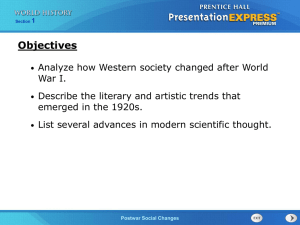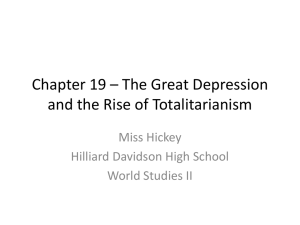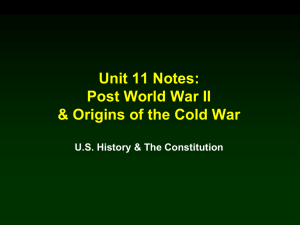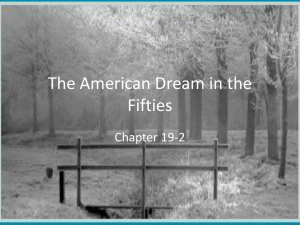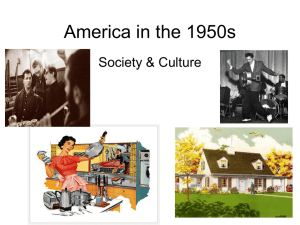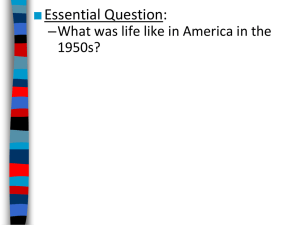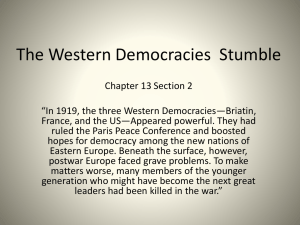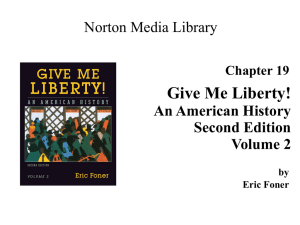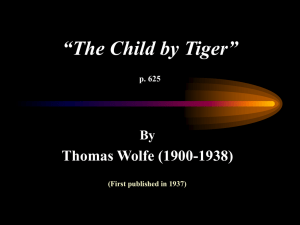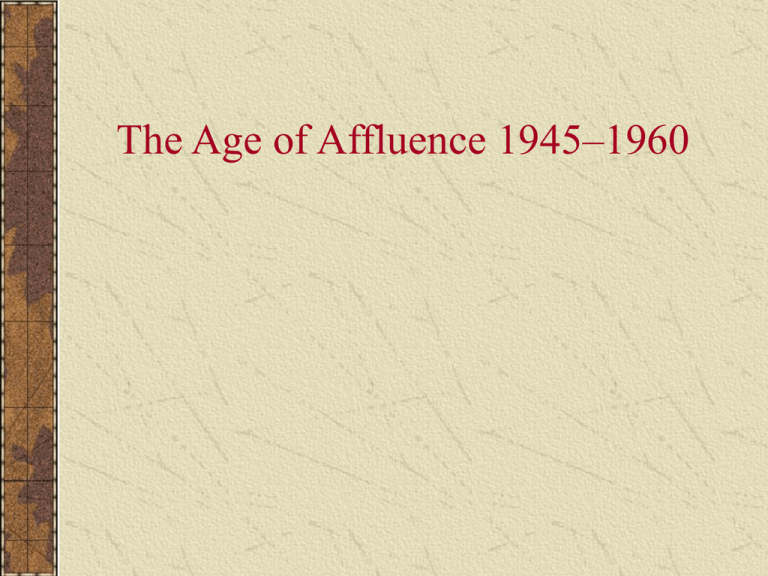
The Age of Affluence 1945–1960
Explain the record of American prosperity
during the two decades following World
War II.
What were the changing roles of cities and
suburbs in American society?
Assess the validity of the “fifties” as the
historical norm of American life.
Who were the members of the “other
America” and why did they occupy this
status?
Economic Powerhouse
Engines of Economic Growth
The Corporate order
By the end of 1945, war-induced prosperity
had made the United States the richest
country in the world, a preeminence that
would continue unchallenged for twenty
years.
At the end of World War II, American economic
hegemony abroad translated into affluence at
home. The weakness of foreign competition
enabled American businesses to exploit foreign
markets when domestic markets were saturated or
experiencing recessions. Millions of new jobs
were created, consumer spending soared, and
inflation was low; the nation entered a period of
unprecedented affluence.
A meeting in Bretton Woods, New
Hampshire, established the U.S. dollar as
the capitalist world’s principal reserve
currency and resulted in the creation of two
global institutions—the International Bank
for Reconstruction and Development
(World Bank) and the International
Monetary Fund (IMF).
The World Bank provided private loans for the
reconstruction of war-torn Europe as well as for
the development of Third World countries, and the
IMF was designed to stabilize the value of
currencies, thereby helping to guide the world
economy after the war.
U.S. economic supremacy abroad helped to boost
the domestic economy, creating millions of new
jobs; the fastest growing sector was white-collar
jobs.
Although the percentage of blue-collar
manufacturing jobs declined slightly during this
period, the power of organized labor reached an
all-time high.
A second linchpin of postwar prosperity was defense
spending. The military-industrial complex that
President Eisenhower identified in his 1961 Farewell
Address had its roots in the businessgovernment
partnerships of the world wars. But unlike after 1918,
the massive commitment of government dollars for
defense continued after 1945.
As permanent mobilization took hold, science,
industry, and the federal government became
increasingly intertwined. According to the National
Science Foundation, federal money underwrote 90
percent of the cost of research on aviation and space,
65 percent for electricity and electronics, 42 percent
for scientific instruments, and 24 percent for
automobiles.
The growth of this military-industrial establishment
had a dramatic impact on national priorities.
Between 1900 and 1930, excepting World War!, the
country spent less than I percent of gross domestic
product (GDP) on the military. By the early 1960s
the figure had risen close to 10 percent.
America's annual GDP jumped from $213 billion in
1945 to more than $500 billion in 1960; by 1970, it
approached $1 trillion. To working Americans, this
sustained economic growth meant a 25 percent rise
in real income between 1946 and 1959. Postwar
prosperity also featured low inflation.
Even so, the picture was not entirely rosy. The
distribution of income remained stubbornly skewed,
and poverty stubbornly hung on: one in thirteen
families at the time earned less than $1,000 a year
The Corporate Order
For more than half a century, American enterprise had
favored the consolidation of economic power into big
corporate firms. That tendency continued and even
accelerated.
The classic, vertically integrated corporation of the
early twentieth century served a national market. This
strategy worked even better in the 1950s. when
sophisticated advertising and the modern media
enabled large corporations to break into hitherto
resistant markets.
National firms now added a new strategy of
diversification. CBS. for example. hired the
Hungarian inventor Peter Goldmark, who perfected
color television during the 1940s, long-playing
records in the 1950s, and a video recording system in
the 1960s.
More revolutionary was the sudden rise of the
conglomerates, giant enterprises comprised of
firms in unrelated industries. Conglomeratebuilding resulted in the nation's third great merger
wave (the first two had taken place in the 1890s
and the 1920s). Because of their diverse holdings,
conglomerates shielded themselves from
instability in any single market and seemed better
able to compete globally.
Expansion into foreign markets also spurred
corporate growth. At a time when "made in
Japan" still meant shoddy workmanship. U.S.
products were considered the best in the world.
In their effort to direct such giant enterprises managers placed
more emphasis on planning. Companies recruited top executives
who had business-school training. the ability to manage
information, and skills in corporate planning, marketing, and
investment.
To man their bureaucracies. the postwar corporate giants
required a huge supply of white-collar foot soldiers. They turned
to the universities. which, fueled partly by the GI Bill, grew
explosively after 1945.
Climbing the corporate ladder rewarded men without hard
edges-the "well adjusted."
In The Lonely Crowd (1950), sociologist David Riesman
contrasted the independent businessmen and professionals of
earlier years with the managerial class of the postwar world. He
concluded that the new corporate men were "otherdirected; more
attuned to their associates than driven by their own goals.
Labor-Management Accord
For blue-collar workers. collective
bargaining after World War II became for
the first time the normal means for
determining how their labor would be
rewarded.
General Motors implacably resisted this "opening
wedge" into the rights of management. The company
took a 1l3-day strike, rebuffed the government's
intervention, and soundly defeated the United Auto
Workers (UAW) union. Having made its point,
General Motors laid out the terms for a durable
relationship. It would accept the UA Was its
bargaining partner and guarantee GM workers an ever
higher living standard.
The price was that the UA W abandon its assault on
the company's "right to manage."
On signing the five-year GM contract of 1950 -the
Treaty of Detroit, it was called- Walter Reuther, leader
of the UAW, accepted the company's terms.
In postwar Europe, America's allies were
constructing welfare states. That was the
preference of American unions as well . But
having lost the bruising battle in Washington for
national health care, they turned to the bargaining
table. By the end of the 1950s, union contracts
commonly provided defined benefit pension plans
(supplementing Social Security), company-paid
health insurance, and for two million workers,
mainly in steel and auto, a guaranteed annual wage
(via supplementary unemployment benefits).
In 1955, the Congress of Industrial Organizations
(CIO) and the American Federation of Labor
(AFL) merged, creating the AFLCIO, which
represented over 90 percent of America’s 17.5
million union members.
In exchange for fewer strikes, corporate managers
often cooperated with unions, agreeing to
contracts that gave workers secure, predictable,
and steadily rising incomes.
Consumer spending soared, and inflation was low;
yet the boon was marred by periodic bouts of
recession and unemployment that particularly hurt
low-income and nonwhite workers.
The sum of these union gains was a new
sociological phenomenon, the "affluent" worker-as
evidenced by relocation to the suburbs (half of an
workers by 1965), by homeownership, by
increased ownership of cars and other durable
goods, and, an infallible sign of rising
expectations, by installment buying. For union
workers, the contract became, as Reuther boasted,
a passport into the middle class.
The labor-management accord that generated
labor's good life seemed in the 1950s to be
absolutely secure. The union rivalries of the 1930s
had abated. In 1955, the industrial-union and craftunion wings joined together in the AFt-CIO,
representing 90 percent of the nation's 17.5
million union members.
Though impressive, the labor-management accord
was never as durable as it seemed. Vulnerabilities
lurked, even in the accord's heyday. For one thing,
the sheltered markets -the essential conditionwere in fact quite fragile.
The postwar labor-management accord. it turns
out. was a transitory event. not a permanent
condition of American economic life. And, in a
larger sense. that was true of the postwar boom. It
was a transitory event, not a permanent condition.
II. The Affluent Society
The Affiuent Society
The Suburban Explosion
Americans began to leave older cities in the
North and Midwest for newer ones in the
South and West; there was also a major shift
from city to the suburbs.
Both processes were stimulated by the
dramatic growth of a car culture and the
federal government’s support of housing
and highway initiatives.
By 1960 more Americans lived in suburbs
than in cities; because few new dwellings
had been built during the depression or war
years, the country faced a housing shortage.
Arthur Levitt applied mass-production
techniques to home construction; other
developers followed suit in subdivisions all
over the country, hastening the exodus from
farms and cities.
Abraham,
William, and
Alfred Levitt
Before and after aerials showing Island
Trees, New York, site of the first Levittown
development.
The first Levittown sprang to life in 1947 on 1200
acres of potato fields on Long Island. To speed
production and cut costs, Levitt offered just two
basic house types. The scale of the project
attracted national attention and made Levitt and
Sons a household name. Veterans and their
families applied by the thousands to rent and later
buy one of Levitt’s mass-produced homes.
Many homes were financed with mortgages
from the Federal Housing Administration
(FHA) and the Veterans Administration at
rates dramatically lower than those offered
by private lenders demonstrating the way
the federal government was entering and
influencing daily life.
New suburban homes, as well as their
funding, were reserved mostly for whites;
some homeowners had to sign a restrictive
covenant prohibiting occupation in the
development by blacks, Asians, or Jews.
Although Shelley v. Kraemer (1948) ruled
that restrictive covenants were illegal, the
practice continued until the civil rights laws
of the 1960s banned private discrimination.
New growth patterns were most striking in
the South and West, where inexpensive
land, unorganized labor, low taxes, and
warm climates beckoned; California grew
the most rapidly.
Automobiles were essential to the growth of
suburbs and to the development of the “Sun
Belt”; the 1950s gas guzzlers became
symbols of status and success.
Highways were funded by federal
government programs such as the National
Interstate and Defense Highway Act of
1956; air pollution and traffic jams soon
became problems in cities.
As Americans began to drive to suburban
shopping malls and supermarkets,
downtown retail economy dried up, helping
to precipitate the decay of the central cities.
Lower Bucks was close to population centers
(Philadelphia and Trenton), improved highways
(including the Pennsylvania Turnpike) and, best of
all, jobs. U.S. Steel broke ground for its new
Fairless Works Division along the western bank of
the Delaware River in early 1951. At the time, the
Fairless Works was the second largest integrated
plant on the East Coast, and the 12th largest steel
mill in the country.
The new suburbs
combined country
comforts with city
conveniences. With
the help of modern
production and
financing methods,
builders like Levitt
and Sons made the
American dream of
homeownership
affordable to
millions.
The Search for Security
There was a reason for Congress calling the 1956
legislation creating America's modern freeway
system the National Interstate and Defense
Highways Act. The four-lane freeways, used every
day by commuters, might some day, in a nuclear
war, evacuate them to safety. That captured as well
as anything the underside of postwar life, when
suburban living abided side by side with the
shadow of annihilation.
The cold war, reaching as it did across the
globe, was omnipresent at home as well.
The nuclear standoff with the Soviet Union
was alarming. Bomb shelters and civil
defense drills provided a daily reminder of
mushroom clouds. In the late 1950s, a small
but growing number of citizens raised
questions about radioactive fallout from
above-ground bomb tests.
By the late 1950s, public concern over
nuclear testing had become a high-profile
issue, and new antinuclear groups such as
SANE (the National Committee for a Sane
Nuclear Policy) and Physicians for Social
Responsibility called for an international
test ban.
After the depression, Americans yearned for
security and a reaffirmation of traditional;
this yearning manifested itself in a renewed
national emphasis on religion and an
ecumenical movement in American
churches.
Church membership jumped from 49 percent of
the population in 1940 to 70 percent in 1960.
People flocked especially into the evangelical
Protestant denominations, which benefited from a
remarkable new crop of preachers. Most notable
was the young Reverend Billy Graham, who made
brilliant use of television, radio, and advertising to
spread the Gospel.
The resurgence of religion, despite its evangelical
bent, had a distinctly moderate tone. An
ecumenical movement bringing Catholics,
Protestants, and Jews together flourished, and so
did a concern for the here and now.
In 1954, the phrase “under God” was
inserted into the Pledge of Allegiance, and
in 1956 Congress added “In God We Trust”
to all U.S. coins.
Norman Vincent Peale’s The Power of
Positive Thinking embodied the trend
toward the therapeutic use of religion in
order to assist Americans in coping with the
stresses of modern life.
Critics suggested that middle-class interest in
religion stemmed not so much from a
renewed spirituality as from a surging
impulse toward conformity; however, the
revival nonetheless spoke to Americans’
search for spiritual meaning in uncertain
times.
American Life during the Baby
Boom
The postwar years are remembered as a time of
affluence and stability, when Americans enjoyed
an optimistic faith in progress and technology and
a serene family-centered culture, reflected in a
booming birthrate known as the baby boom and
enshrined in television sitcoms such as Father
Knows Best.
This powerful myth has some truth to it, but does
not do justice to this complex period of economic
and social transformation, which included
challenges to the status quo as well as conformity.
Consumer Culture
In some respects, postwar consumerism seemed like
a return to the 1920s-an abundance of new gadgets
and appliances, more leisure time, the craze for
automobiles, and new types of mass media. Yet there
was a significant difference. In the 1950s,
consumption became associated with citizenship.
Buying things, once a sign of personal indulgence,
now meant fully participating in American society
and, moreover, fulfilling a social responsibility.
As in the past, product makers sought to stimulate
consumer demand through aggressive advertising.
More money was spent in 1951 on advertising ($6.5
billion) than on primary and secondary education
($5 billion).
Consumers had more free time in which to spend
their money; millions took to the interstate
highways, spurring dramatic growth in motel
chains, restaurants, and fast-food eateries.
Perhaps the most significant hallmark of postwar
consumer culture was television, which supplanted
radio as the chief diffuser of popular culture; it
portrayed American families as white, middleclass suburbanites, and nonwhite characters were
usually servants.
The new prosperity of the 1950s was aided
by a dramatic increase in consumer credit,
which enabled families to stretch their
incomes; between 1946 and 1958 short-term
consumer credit rose from $8.4 billion to
almost $45 billion.
The Diners Club introduced the first credit
card in 1950, followed by the American
Express card and Bank Americard in 1959;
by the 1970s, the credit card had
revolutionized personal and family finances.
Aggressive advertising by corporations
contributed to the massive increase in
consumer spending.
Advertising heavily promoted the appliances that
began to fill the suburban kitchen. In 1946
automatic washing machines replaced the old
machines with hand-cranked wringers, and clothes
dryers also came on the market.
TV's leap to cultural prominence was swift and
overpowering. There were only 7,000 sets in
American homes in 1947, yet a year later the CBS
and NBC radio networks began offering regular
programming, and by 1950 Americans owned 7.3
million TV sets. Ten years later, 87 percent of
American homes had at least one television set.
The Federal Communications
Commissioner called television “a vast
wasteland”; however, its images of postwar
family life and society fit with the social
expectations of many Americans.
What Americans saw on television, besides
the omnipresent commercials, was an
overwhelmingly white, Anglo-Saxon world
of nuclear families, suburban homes, and
middle-class life.
"Father Knows Best" (1954) -
The Baby Boom
Postwar family demographics changed from
previous years: marriages were remarkably
stable, there was a drop in the average age
at marriage, and the birthrate shot up; the
American population rose dramatically
from 140 million in 1945 to 179 million in
1960, and to 203 million in 1970.
The baby boom prompted a major expansion in
the nation’s education system, and babies’
consumer needs helped to fuel the economy.
To keep all those baby boom children healthy and
happy, middle-class parents increasingly relied on
the advice of experts. Dr. Benjamin Spock's bestselling Baby and Child Care sold a million copies
a year after its publication in 1946. Spock urged
mothers to abandon the rigid feeding and baby
care schedules of an earlier generation.
Coupled with national defense expenditures,
family spending on consumer goods fueled
unparalleled prosperity and economic growth in
the 1950s and 1960s.
Contradictions in Women’s Lives
Parents of baby boomers were expected to
adhere to rigid gender roles as a way of
maintaining the family and undergirding the
social order.
Men were expected to conform to an idea
that emphasized their role as responsible
breadwinners, while women were advised
that their proper place was in the home.
. Endorsing what Betty Friedan called the
"feminine mystique" - the ideal that "the
highest value and the only commitment for
women is the fulfillment of their own
femininity" - psychologists pronounced
motherhood the only "normal" female sex
role and berated mothers who worked
outside the home.
Many working-class women embraced their
new roles as housewives, while at the height
of the postwar period more than a third of
women held jobs outside the home and
coincided with a dramatic rise in the
number of older, married, middle-class
women who took jobs.
Women justified their jobs as an extension
of their family responsibilities, enabling
their families to enjoy more of the fruits of
the consumer -culture.
Working women still bore full responsibility
for child care and household management
allowing families and society to avoid
facing the social implications of their new
roles, departing significantly from the
cultural stereotypes.
Youth Culture and Challenges to
Conformity
The emergence of a mass youth culture had
its roots in the democratization of education
and the increasing purchasing power of
teenagers.
America’s youth were eager to escape
suburban conformity, and they became a
distinct new market that advertisers eagerly
exploited.
What really defined this generation’s youth
culture was its music; the rock ’n’ roll that
teens were attracted to in the 1950s was
seen by white adults as an invitation to
racemixing, sexual promiscuity, and
juvenile delinquency.
In major cities, gay men and women
founded gay rights organizations, but many
gays were still perceived as a threat to
mainstream sexual and cultural norms and
therefore remained closeted.
Postwar artists,musicians, and writers
expressed their alienation from mainstream
society through intensely personal,
introspective art forms.
Jackson Pollock and other painters rejected
the social realism of the 1930s for an
unconventional style that became known as
abstract expressionism, which captured the
chaotic atmosphere of the nuclear age.
A similar trend developed in jazz, as black
musicians originated a hard-driving
improvisational style known as “bebop.”
The Beats were a group of writers and poets
who were both literary innovators and
outspoken social critics of middle-class
conformity, corporate capitalism, and
suburban materialism, who inspired a new
generation of rebels in the 1960s.
The Other America
International and Domestic
Migration to
Cities
With jobs and financial resources flowing to
the suburbs, urban newcomers inherited a
declining economy and a decaying
environment—the “Other America.”
The War Brides Act, the Displaced Persons
Act, the McCarran-Walter Act, and the
repeal of the Chinese Exclusion Act all
helped to create an influx of immigrants
into American cities.
The federal government welcomed Mexican labor
under its bracero program but deported those who
stayed illegally; 4 million Mexicans were deported
during “Operation Wetback.”
Residents of Puerto Rico had been American
citizens since 1917, so they were not subject to
immigration laws; they became America’s first
group to immigrate by air.
Cuban refugees were the third largest group of
Spanish-speaking immigrants; the Cuban refugee
community turned Miami into a cosmopolitan,
bilingual city almost overnight.
Internal migration from rural areas brought large
numbers of people to the cities, especially African
Americans, after the introduction of innovations
like the mechanical cotton picker, which reduced
southern demand for labor.
By 1960, about half of the nation’s black
population was living outside the South, compared
with only 23 percent before World War II.
After the 1953 “Termination” programs, many
Indians settled together in poor urban
neighborhoods alongside other nonwhite groups;
many found it difficult to adjust to an urban
environment and culture.
The Urban Crisis
Between 1950 and 1960, the nation’s twelve
largest cities lost 3.6 million whites and
gained 4.5 million nonwhites.
As affluent whites left the cities, urban tax
revenues shrank, leading to the decay of
services and infrastructure; growing racial
fears accelerated “white flight” to the
suburbs in the 1960s.
In the inner cities, housing continued to be a
crucial problem; urban renewal produced
grim high-rise housing projects that
destroyed community bonds and created
anonymous open areas that were vulnerable
to crime.
Postwar urban areas increasingly became
places of last resort for America’s poor;
once there, they faced unemployment, racial
hostilities, and institutional barriers to
mobility.
Two separate Americas emerged: a largely
white society in the suburbs and an inner
city populated by blacks, Latinos, and other
disadvantaged groups.
In the turbulent decade to come, the contrast
between suburban affluence and the “other
America,” would spawn growing demands
for social change that the nation’s leaders in
the 1960s could not ignore.
In 1962, the Swedish sociologist Gunnar Myrdal
(author of An American Dilemma, a pioneering
book about the country's race relations) wondered
whether shrinking economic opportunity in the
United States might not trap the unemployed and
underemployed at the bottom of society.
Myrdal's term underclass-referring to a population
permanently mired in poverty and dependencywould figure centrally in future American debates
about social policy.
The Emerging Civil Rights Struggle
Civil Rights under Truman
Truman offered support for civil rights not only because he
wanted to solidify the Democrats’ hold on African
American voters but also because he was concerned about
America’s image abroad.
Lacking a popular mandate on civil rights, Truman turned
to executive action; he appointed the National Civil Rights
Commission in 1946, ordered the Justice Department to
prepare a brief for Shelley v. Kraemer (1948), which ruled
against discrimination in home buying, and signed an
executive order to desegregate the army in 1948.
The Kraemers were a white couple who owned a residence in a
Missouri neighborhood governed by a restrictive covenant. This
was a private agreement that prevented blacks from owning
property in the Kraemers' subdivision. The Shelleys were a
black couple who moved into the Kraemers neighborhood. The
Kraemers went to court to enforce the restrictive covenant
against the Shelleys.
Question Presented
Does the enforcement of a racially restrictive covenant violate
the Equal Protection Clause of the 14th Amendment?
Conclusion
State courts could not constitutionally prevent the sale of real
property to blacks even if that property is covered by a racially
restrictive covenant. Standing alone, racially restrictive
covenants violate no rights. However, their enforcement by state
court injunctions constitute state action in violation of the 14th
Amendment.
Southern conservatives blocked Truman’s
proposals for a federal anti-lynching law,
federal protection of voting rights, and a
federal agency to guarantee equal
employment opportunity.
In 1946 he appointed a National Civil
Rights Commission, whose 1947 report
called for robust federal action On behalf of
civil rights. In 1948, under pressure from A.
Phillip Randolph's Committee against Jim
Crow in Military Service, Truman signed an
executive order desegregating the armed
forces.
Challenging Segregation
Legal segregation of the races still governed
southern society in the early 1950s; whites
and blacks were segregated in restaurants,
waiting rooms and toilets at bus and train
stations, and all forms of public
transportation were rigidly segregated, with
even drinking fountains being labeled
“White” and “Colored.”
“Whites Only” Waiting Room
A black man is ordered out of a “whites only”
waiting room. Separate facilities for blacks and
whites were maintained throughout the South from
the end of the 19th century until the 1960s.
" A rest stop for
Greyhound bus
passengers on
the way from
Louisville,
Kentucky to
Nashville,
Tennessee,
with separate
accommodatio
ns for colored
passengers."
With Dwight Eisenhower as president, civil
rights no longer had a champion in the
White House. In the meantime, however,
NAACP lawyers Thurgood Marshall and
William Hastie had been preparing the legal
ground in a series of test cases challenging
racial discrimination, and in 1954 they hit
pay dirt.
The first significant civil rights victory
came in 1954. In Brown v. Board of
Education of Topeka (1954), the Supreme
Court overturned the long-standing
“separate but equal” doctrine of Plessy v.
Ferguson (1896).
A landmark civil rights case. the Brown v. Board of
Education decision involved Linda Brown. a black
pupil in Topeka. Kansas. who had been forced to
attend a distant segregated school rather than the
nearby white elementary school. The NAACP's
chief counsel. Thurgood Marshall. argued that such
segregation, mandated by the Topeka Board of
Education, was unconstitutional because it denied
Linda Brown the "equal protection of the laws"
guaranteed by the Fourteenth Amendment.
In a unanimous decision on May 17. 1954. the
Supreme Court agreed. overturning the "separate
but equal" doctrine of Plessy v. Ferguson.
Does segregation of children in public
schools solely on the basis of race, even
though the physical facilities and other
"tangible" factors may be equal, deprive the
children of the minority group of equal
educational opportunities? We believe that it
does.
Over the next several years, the Supreme Court
used the Brown case to overturn segregation in
public recreation areas, transportation, and
housing.
In the Southern Manifesto of 1956, southern
members of Congress denounced the Brown
decision as an abuse of judicial power and
encouraged their constituents to defy the ruling;
White Citizens’ Councils in the South sprouted up
dedicated to blocking school integration and other
civil rights measures and the ranks of the Ku Klux
Klan (KKK) swelled.
President Eisenhower accepted the Brown
decision as the law of the land. but he
thought it was a mistake and was not happy
about committing federal power to enforce
it.
A crisis in Little Rock. Arkansas, finally forced his
hand. In September 1957, nine black students
attempted to enroll at the all-white Central High
School. Governor Orval Faubus called out the
National Guard to bar them. Then the mob took
over. Every day the nine students had to run a
gauntlet of angry whites chanting "Go back to the
jungle."
As the vicious scenes played out on television
night after night, Eisenhower acted. He sent 1,000
federal troops to Little Rock and nationalized the
Arkansas National Guard, ordering them to protect
the black students. Eisenhower thus became the
first president since Reconstruction to use federal
troops to enforce the rights of blacks.
President Eisenhower ordered the 101st
Airborne Division into Little Rock to insure the
safety of the "Little Rock Nine" and that the
rulings of the Supreme Court were upheld.
The Brown decision validated the NAACP's
legal strategy, but white resistance also
revealed that winning in court was not enough.
Prompted by one small act of defiance,
southern black leaders embraced nonviolent
protest.
Little Rock Police work to keep protesters behind
barricades at Central High on Sept. 27, 1957.
Students wait beside Arkansas National Guard troops
blocking their admission to Little Rock Central High.
Rosa Parks’s refusal to give up her bus seat
to a white person prompted the 381-day
1956 Montgomery bus boycott, which
ended only when the Supreme Court
declared bus segregation unconstitutional.
Once the die was cast, the black community
turned for leadership to the Reverend
Martin Luther King Jr., the recently
appointed pastor of Montgomery's Dexter
Street Baptist Church. The son of a
prominent black minister in Atlanta, King
embraced the teachings of Mahatma Gandhi
(learned from Thoreau), whose campaigns
of passive resistance had led to India's
independence from Britain in 1947.
After Rosa Parks' arrest. King endorsed a
plan by a local black women's organization
to boycott Montgomery's bus system until it
was integrated. Once the die was cast, the
black community turned for leadership to
the Reverend Martin Luther King Jr., the
recently appointed pastor of Montgomery's
Dexter Street Baptist Church.
The Montgomery bus boycott catapulted
King to national prominence. In 1957, along
with the Reverend Ralph Abernathy, he
founded the Southern Christian Leadership
Conference (SCLC) , based in Atlanta. The
black church, long the center of African
American social and cultural life, now lent
its moral and organizational strength to the
civil rights movement.
The battle for civil rights entered a new phase in
Greensboro, North Carolina, on February I, 1960,
when four black college students took seats at the
"whites-only" lunch counter at the local
Woolworth's. They were determined to "sit in"
until they were served. Although they were
arrested, the sit-in tactic workedthe Woolworth's
lunch counter was desegregated-and sit-ins
quickly spread to other southern cities.
The victories so far had been limited, but the
groundwork was laid for a civil rights offensive
that would transform the nation's race relations.



